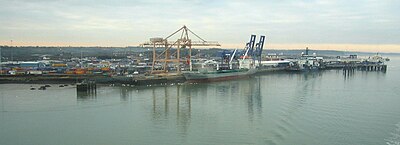
Harwich is a town in Essex, England and one of the Haven ports, located on the coast with the North Sea to the east. It is in the Tendring district. Nearby places include Felixstowe to the northeast, Ipswich to the northwest, Colchester to the southwest and Clacton-on-Sea to the south. It is the northernmost coastal town within Essex.

Stena Line is a Swedish shipping line company and one of the largest ferry operators in the world. It services Denmark, Germany, Ireland, Latvia, the Netherlands, Norway, Poland, Sweden and the United Kingdom, Stena Line is a major unit of Stena AB, itself a part of the Stena Sphere. Stena Line also owns the Swedish vessels of the otherwise German and Danish owned Scandlines.

Sealink was a ferry company based in the United Kingdom from 1970 to 1984, operating services to France, Belgium, the Netherlands, Isle of Man, Channel Islands, Isle of Wight and Ireland.
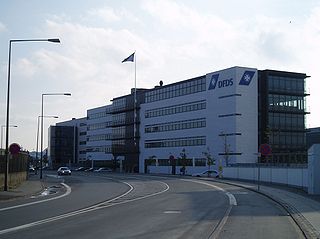
DFDS is a Danish international shipping and logistics company. It is the busiest shipping company of its kind in Northern Europe and one of the busiest in Europe. The company's name is an abbreviation of Det Forenede Dampskibs-Selskab. DFDS was founded in 1866, when C.F. Tietgen merged the three biggest Danish steamship companies of that day.

Parkeston is a North Sea port, village and electoral ward village in Essex, England, situated on the south bank of the River Stour about one mile (1.6 km) up-river from Harwich. In 2018 it had an estimated population of 932.

The Mayflower line is a railway branch line in the east of England that links Manningtree, on the Great Eastern Main Line, to Harwich Town. During peak times, many services connect to or from the main line and its London terminus at Liverpool Street. The Mayflower line has six stations, including the two termini, and is situated within the county of Essex.

Harwich International railway station is on the Mayflower Line, a branch of the Great Eastern Main Line, in the East of England, serving Harwich International Port and the Parkeston area of Essex. It is 68 miles 72 chains (110.88 km) from London Liverpool Street and is situated between Wrabness to the west and Dovercourt to the east. Its three-letter station code is HPQ, which derives from its original name, Harwich Parkeston Quay.

Dutchflyer is an integrated passenger service between the United Kingdom and the Netherlands. Formerly known as Amsterdam Express, Dutchflyer is a rail/sea/rail service operated jointly by Stena Line, the Dutch state railway operator Nederlandse Spoorwegen, the Rotterdam metro and bus company Rotterdamse Elektrische Tram and NS’ UK subsidiary Greater Anglia.

Harwich Town railway station is the eastern terminus of the Mayflower Line, a branch of the Great Eastern Main Line, in the East of England, serving the port town of Harwich, Essex. It is 70 miles 61 chains (113.88 km) from London Liverpool Street; the preceding station on the line is Dovercourt. Its three-letter station code is HWC.

DFDS Seaways is a Danish shipping company that operates passenger and freight services across northern Europe. Following the acquisition of Norfolkline in 2010, DFDS restructured its other shipping divisions into the previously passenger-only operation of DFDS Seaways.
Stena Line Holland BV is a subsidiary of Stena Line that operates ferry routes between Harwich and Killingholme on the east coast of England and Hoek van Holland and Europort in the Netherlands. The head office is in Hoek van Holland in the Netherlands. Apart from during the two world wars there has been a continuous service operating between these two countries, initially by the railway companies serving the east coast of England together with Stoomvaart Maatschappij Zeeland a Dutch ferry company. In 1990 Stena Line had purchased both parts and Stena Line Holland BV came into being.
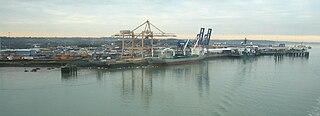
HMS Badger was a shore establishment of the Royal Navy on the east coast of the United Kingdom. She was commissioned on 13 September 1939 was the flag ship of the headquarters of the Flag Officer in Charge (FOIC), Harwich who was responsible to Commander-in-Chief, The Nore, and was decommissioned on 21 October 1946, although the Operations Room remained as the Emergency Port Control for the Harwich area. The site was Parkeston Quay, now Harwich International Port, and the bunker lies under Hamilton House, currently an occupational health centre, close to the entrance to Harwich International Port, a few miles west of Harwich.

One World Karadeniz is a former high-speed ferry that operated Stena Line's Holyhead–Dún Laoghaire service between Great Britain and Ireland until 2015. It is a member of the HSS 1500 class of high-speed ferries introduced and developed by Stena Line from 1996 onwards. The HSS 1500 class vessels became the largest catamarans in service in the world.
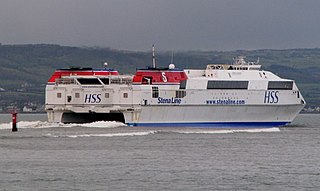
Stena Voyager was a high-speed ferry owned by Stena Line which used to operate on their Belfast–Stranraer service. It was a member of the HSS 1500 class of high-speed ferries developed and introduced by Stena Line from 1996 onwards.
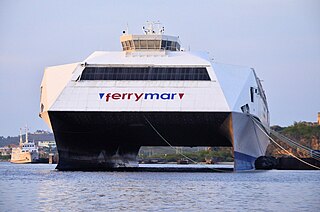
HSS Discovery was a high-speed ferry owned by Albamar Shipping Company. It is a member of the HSS 1500 class of high-speed ferries built for and designed by Stena Line from 1996 onwards. The vessel was previously named Stena Discovery and operated for Stena Line between Harwich International Port, in the United Kingdom and Hoek van Holland, in The Netherlands.

Stoomvaart Maatschappij Zeeland was a Dutch ferry operator that ran services from the Netherlands to the United Kingdom between 1875 and 1989.
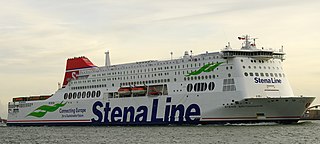
Stena Britannica, launched in 2009, is the second of two identical RoPAX ferries built by Wadan Yards in Warnemünde and nearby Wismar, Germany for Stena Line. The first of the two ships, launched in January 2010, was Stena Hollandica. Both ships operate across the southern North Sea between Harwich in Essex, England, and Hoek van Holland, Netherlands, providing a twice daily service. The ships were specifically designed for this route.
Suffolk Ferry was a train ferry built for the London and North Eastern Railway in 1947. She was subsequently operated by British Railways and Sealink before being withdrawn in 1980 and scrapped in Belgium in 1981.

Speedlink Vanguard was a 3,514 GRT train ferry which was built in 1973 as Stena Shipper. She was charted to a New Zealand operator on completion and renamed Union Wellington and saw further service as Alpha Express and Stena Shipper before entering service with Sealink as Speedlink Vanguard. The ship was involved in a collision with European Gateway in 1982, which sank the latter ship with the loss of six lives.

MS Wawel is a ferry launched in 1979 as the Scandinavia. She spent a large part of her career serving the Dover-Calais cross channel ferry route with successive operators. She is currently in service with Polferries as the Wawel.
